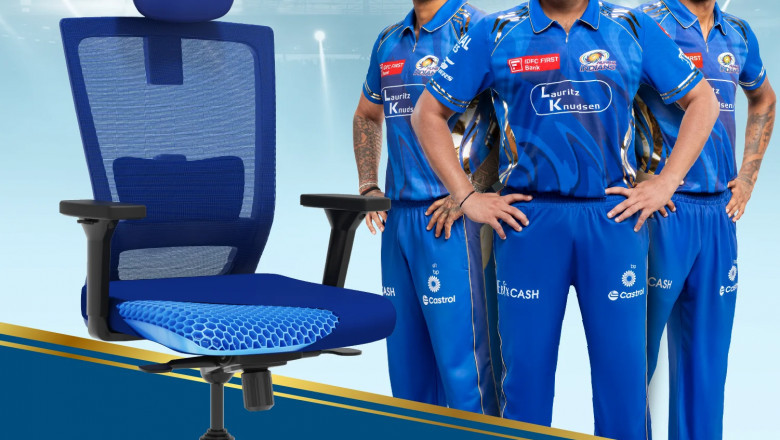views
Introduction: Why Chair Choice Matters in a Workspace
In modern workspaces, where hours are spent glued to desks, the chair you choose becomes more than just a piece of furniture—it shapes your productivity, posture, comfort, and long-term health. While the market offers a range of seating options, the debate between revolving chairs and fixed chairs remains one of the most common. Is it better to have the flexibility and dynamic support of a revolving chair? Or is a fixed chair, with its traditional structure, more beneficial for work discipline and back support?
This article explores the essential differences between revolving chairs and fixed chairs, focusing on ergonomic impact, mobility, productivity enhancement, and comfort. Whether you're upgrading your home office, setting up a commercial workspace, or simply curious, we’ll help you make a more informed decision.
1. Understanding the Basics: What Are Revolving and Fixed Chairs?
Before comparing the two, it's essential to understand what sets these chairs apart:
-
Revolving Chair: A rotating chair that usually includes wheels, a swivel base, adjustable height, and lumbar support. Common in modern offices.
-
Fixed Chair: A stationary chair with four legs or a fixed base. Limited adjustability and no movement. Often seen in waiting areas or traditional desks.
Design Purpose:
-
Revolving chairs are designed for active, multitasking environments.
-
Fixed chairs are meant for more static and formal setups.
2. Ergonomics and Comfort: The Real Game-Changer
Revolving Chair Ergonomics:
-
Adjustable seat height and backrest.
-
Armrest support reduces shoulder tension.
-
Swivel function reduces body strain from turning or reaching.
-
Designed to support natural body posture.
Fixed Chair Ergonomics:
-
Rarely includes adjustments.
-
May lack lumbar support.
-
Fixed height and rigid back make long sitting hours uncomfortable.
Verdict: Revolving chairs lead in comfort and body alignment, especially for those sitting 6–8+ hours a day.
3. Productivity Boost: Does Mobility Equal More Work Done?
Mobility plays a silent but powerful role in workplace efficiency.
-
With Revolving Chairs:
-
Easily switch between multiple screens or files.
-
Less time wasted standing or stretching to reach something.
-
Movement keeps blood circulation better than fixed sitting.
-
-
With Fixed Chairs:
-
Movement is restricted, creating physical strain.
-
Tasks like turning to pick up a phone or book are inconvenient.
-
A study by ergonomics researchers shows that adjustable, mobile chairs increase productivity by up to 17% in long sitting jobs. The flexibility allows natural movement, which supports focus.
4. Back Health and Posture Over Time
Bad posture isn’t just uncomfortable—it leads to long-term health issues like spinal misalignment, disc compression, and neck strain.
-
Revolving chairs with proper lumbar support help:
-
Maintain spinal curves.
-
Avoid slouching or leaning.
-
Reduce pressure on the lower back.
-
-
Fixed chairs, in contrast:
-
Often force the user into stiff or unnatural postures.
-
Offer no dynamic support when posture shifts.
-
Doctors recommend revolving chairs for people with a sedentary job or a history of back pain.
5. Adjustability and Custom Fit
Revolving chairs are built with personalization in mind. Key adjustability features include:
-
Height control to match desk level.
-
Reclining backrest to support breaks and body posture.
-
Armrest adjustments for typing posture.
Fixed chairs are limited to “one-size-fits-all,” which rarely matches the user's actual need.
Result: A revolving chair offers a tailored sitting experience, reducing fatigue and improving energy throughout the workday.
6. Cost vs. Value Over Time
-
Initial Cost:
-
Fixed chairs are cheaper upfront.
-
Revolving chairs come with a higher price tag due to materials and mechanisms.
-
-
Value Over Time:
-
Revolving chairs reduce medical bills, increase productivity, and last longer with proper care.
-
Fixed chairs may require replacement faster due to wear and discomfort complaints.
-
So while the initial investment may be higher for revolving chairs, the ROI (return on investment) in terms of health and productivity is often greater.
7. Where Each Chair Fits Best
Revolving Chairs Are Ideal For:
-
Remote workers.
-
IT professionals and coders.
-
Managers and multitaskers.
-
Long working hours (6+ hours daily).
Fixed Chairs Are Suitable For:
-
Waiting areas or meeting rooms.
-
Short-term tasks or less desk-oriented roles.
-
Limited budgets or minimal workspace design.
8. Noise and Floor Impact
One concern with revolving chairs is the noise from wheels and movement, especially on tile or wooden floors. However, high-quality models reduce this with rubber-coated wheels.
Fixed chairs are silent but can scrape floors if dragged. Using floor mats or protectors can help.
9. Style and Aesthetics
If you're going for a modern, sleek workspace vibe, revolving chairs come in all designs—from executive leather models to minimalist mesh ones.
Fixed chairs may look more elegant in classic or formal spaces but might feel outdated in tech-forward setups.
10. User Experience and Real-Life Testimonials
Most users who switch from fixed to revolving chairs report noticeable improvement in:
-
Back comfort.
-
Ability to stay focused.
-
Less physical exhaustion.
Office HR surveys also reveal employees feel more motivated in ergonomically designed environments.
Conclusion: Which Chair Is Right for You?
The answer lies in how you work and what your daily routine looks like. If you're spending most of your time at a desk, a revolving chair is your best companion—built for comfort, efficiency, and long-term well-being.
However, for areas where seating is temporary or less dynamic, fixed chairs still hold their place.





















Comments
0 comment